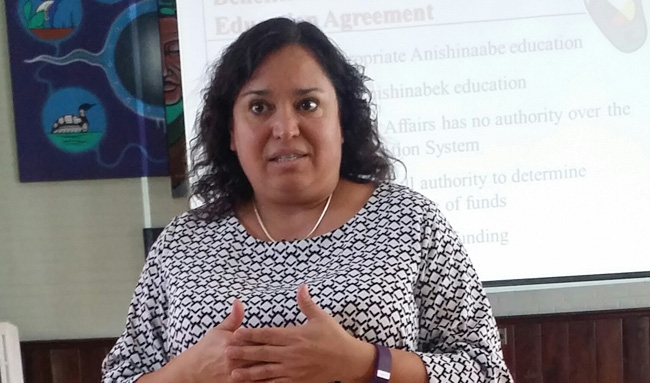Saying yes to the AES in Toronto

By Barb Nahwegahbow
TORONTO – It’s taken 20 years for the Anishinabek Nation to negotiate with Canada the Anishinabek Nation Education Agreement. The Agreement establishes First Nation jurisdiction over JK to Grade 12 education, establishes the Anishinabek Education System (AES) and Canada’s funding support for the AES. Funding has been negotiated for education programs and services, governance and implementation of the AES.
A massive communication campaign is currently underway to reach out to Anishinabek communities to inform them about the AES. Anishinabek citizens are required to ratify the AES. The ratification vote period is November 28 – December 2, 2016. Polling stations will be set up at member First Nations as well as urban centres, including Toronto.
The AES Communication team held an Education Ratification Information Session on February 17 in Toronto at the Native Canadian Centre. There were participants from Alderville First Nation and Aamjiwnaang First Nation in attendance.
In the 3-hour workshop, lawyer Tracey O’Donnell presented a summary of the negotiations and the details of the resulting Anishinabek Education System. O’Donnell, a member of Red Rock Indian Band is the negotiator for the Union of Ontario Indians.
“Our high school graduation rates don’t match the rest of Canada,” said O’Donnell, “and that tells us we need to do something different.” (The rate of First Nation graduation is 36% while the Canadian graduation rate is 72%.)
The AES will be very different from what is currently available for First Nation students. It is grounded in Anishinaabe culture, and will promote Anishinaabe language and customs. Providing education that is relevant to the culture, needs and life experiences of Anishinabek students will increase self-esteem and cultural pride which will increase student success. A short film that was shown at the information session bears this out. The film featured Anishinabek youth at a summer retreat talking with passion and longing about what and how they want to learn. They want to learn their language, learn from Elders, and spend time out of the classroom and in the bush to learn from the land.
A crucial component of the AES, said O’Donnell, is putting into place measurable goals for increasing student achievement and well-being. Results will be assessed on an annual basis and goals changed if necessary.
First Nations will have full authority to determine educational priorities and how to best spend the funds to meet the educational priorities and needs. The Minister of Indian Affairs will have no authority over the AES.
The governance system for the AES, explained O’Donnell, includes First Nations, five Regional Education Councils (REC) and a central Kinoomaadziwin Education Body (KEB).
Each First Nation will appoint two representatives to their respective REC. The KEB will have two representatives from each of the five Regional Education Councils. The KEB will receive the funds from Canada and will administer and distribute funds to the First Nations. Financial accountability on the part of First Nations is to the KEB.
The AES will impact elementary and secondary school students who are citizens of the Anishinabek Nation no matter where they live. In Toronto, implementation of the AES will require discussions with the city’s school boards.
To learn more about the AES and to prepare for the ratification vote, check out the website: www.sayyestoaes.ca; attend an AES information session and take friends and family with you; ask your Chief and Council to schedule an information session for your community. If you live off-reserve, make sure your First Nation has your current mailing address so they can send you updates and notices for the vote this fall.

